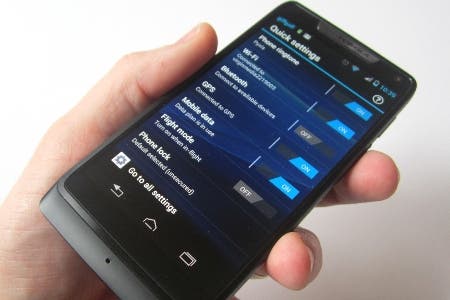Motorola Razr I review
Intel is gunning for mobile success, but does it give this Razr the edge? Digital Foundry finds out.
Chip maker Intel isn't content to just make computer parts these days. The veteran semiconductor manufacturer entered the mobile phone arena - dominated by the likes of Qualcomm and NVIDIA - with its Medfield chipset a while back, which made its UK debut in the likeable Orange San Diego. However, the latest Medfield variant - clocked at a fearsome 2GHz - could mark the beginning of a concerted push by Intel to capture more of what is an incredibly profitable business.
Motorola has fused this new chipset into the chassis of the Razr M, and given it a suitable rebranding as the Razr I - no prizes for guessing what that letter stands for at the end. From a purely external viewpoint, the M and I are all but identical - the biggest aesthetic change being the addition of a dedicated camera button on the latter model. The 4.3-inch Super AMOLED display pops with colour and contrast, while the slim body - which boasts an unusual combination of metal and super-tough Kevlar - is far more appealing that it has any right to be.
However, what's contained within this updated edition makes it worthy of a second look, especially at the modest SIM-free price of around £340. While the Razr M uses a 1.5GHz dual-core Qualcomm Snapdragon S4 CPU, the Razr I is packing a 2GHz Atom Z2480 processor. It may only be a single-core offering, but it boasts Intel's fancy hyperthreading technology and offers up a surprisingly robust level of performance. Perhaps this is not surprising based on the fact that at an architectural level this is essentially an overclocked version of the same core that powered the Netbook craze from a couple of years back.
Design: Razr sharp in more ways than one
We've become so accustomed to monster-sized mobiles lately that a device like the Razr I feels almost dainty in comparison; just over 8mm thick at its widest point, the handset tapers from top to bottom to create a subtle wedge-like shape which rests comfortably in the palm. Because Motorola has decided against using a replaceable battery, it has resulted in a tighter, sturdier construction. There's a weight and heft to the Razr I which makes it feel solid and dependable - the same qualities which Apple has a habit of imbuing in its own products.
Sadly, there are elements of the design which make the Razr I feel like it includes the disjointed ideas of many people rather than just one singular vision. The front of the device is dominated by the much-hyped 'edge to edge' display, which in reality has a noticeable metal bezel. The main body of the phone is half metal, half plastic, and comes coated with a matte covering which chips away on the metal portion with alarming ease. The back of the phone is fashioned from kevlar, which never really seems to fit within the context of the overall design.
Add to this a series of hardware buttons which again refuse to follow any kind of pattern (the power button is silver while the volume rocker and camera key are black) and visible screws (Steve Jobs' pet hate) and what you're left with is an attractive - but still somewhat confused - device.
While the design might divide opinion, the 4.3-inch Super AMOLED screen is unlikely to cause the same degree of consternation. With a resolution of 540x960 pixels and sporting a density of 256ppi, it may not be the sharpest display around but the punchy colours and deep, vibrant blacks more than make up for it. So striking is the display's reproduction of colour that it allows you to overlook the pentile pixel arrangement and the slight yellow tinge to some of the whites.
Intel's Medfield chipset is arguably the main reason for mobile tech fans to take notice of this rebadged Razr I, however. For a single core phone, Motorola's latest offering certainly isn't lacking in pace, and according to benchmarks such as AnTuTu and Quadrant, it comfortably outperforms the dual-core Galaxy Nexus, although the quad-core power of the HTC One X remains out of reach. However, Anandtech's iPhone 5 review features a number of CPU benchmarks revealing that the Intel core outstrips everything on the market. Bearing in mind that this is a five-year-old netbook x86 core upped from its default 1.6GHz to 2GHz, it puts the world of mobile processing power in general into perspective somewhat.
Moving around the OS is generally smooth, as is switching between open applications. However, the experience is maddeningly inconsistent; some very basic actions cause the interface to stutter and jerk quite noticeably, despite the fact that you're placing very modest demands on the CPU. It's hard to say if the problem lies with the hardware or the software, but whatever the reason, it takes the shine off what could have been a very impressive UI.
"The Intel CPU core keeps pace with the fastest performers in the market, but the GPU is well off pace, resulting in average 3D gaming performance."
| Samsung Galaxy Nexus (Android 4.1) | HTC One X | Razr I | |
|---|---|---|---|
| Quadrant Standard | 2078 | 4870 | 3205 |
| AnTuTu Benchmark | 4724 | 11065 | 8420 |
| Vellamo | 1199 | 1661 | 1521 |
| GLBenchmark 2.5.1 Egypt Classic Off-Screen | 14.8FPS | 38.7FPS | 19FPS |
Software: Ice Cream Sandwich with a twist
Another worrying drawback of using Intel tech is that many applications on the Google Play store aren't compatible with it yet. Google's Chrome browser was one early high-profile casualty, although Google has updated the app now to ensure compatibility with Intel's tech. Many smaller developers aren't going to be as dedicated, which means that the Razr I is a poor choice if you're especially keen on downloading the latest apps and games.
Under its svelte exterior, the Razr I is sporting Android 4.0.4. That means no Jelly Bean, which consequently means no Google Now or Project Butter. Given that Android 4.1 is only just arriving on other high-profile handsets, this isn't that much of a blow, but it does seem odd that Motorola - now owned by Google, lest we forget - can't maintain pace with the very latest software updates. The release of the Nexus 4 marks the debut of Android 4.2, which means the Razr I is even further off the pace.
However, Motorola's software engineers have at least tried to give the Razr I a unique interface. The home screen arrangement has been tinkered with, and swiping to the left now reveals a selection of quick settings, allowing you to control aspects such as Wi-Fi, Bluetooth, GPS and Flight Mode. This kind of 'quick settings' menu is usually concealed in the drop-down notifications area on other Android devices, but by effectively making it a home screen in itself, Motorola has sped up the process of toggling various key functions. The versatility of Android's home screen setup hasn't been compromised, thankfully - although the default number is set to just two, you can add more screens (up to a total of seven) if you so wish.
"Motorola was acquired by Google, but bizarrely this new phone ships with Android 4.0.4 meaning no Google Now or Project Butter OS performance enhancements."
Motorola has also introduced some unique widgets, the most appealing of which is the Circles widget. This comprises of a trio of circles with time, weather and battery life displayed in each. In a neat touch, it's possible to flip these circles using your finger and access other functions. For example, spinning the clock allows you to toggle between an analogue and digital display - text messages and missed calls also appear in this area. The other big innovation is SmartActions, Motorola's attempt to factor in the kind of automation afforded by Android apps such as Tasker and Locale.
For example, you can create a SmartAction which automatically dims the brightness of the screen when the phone's battery drops below a certain level, or have your music player automatically launch whenever you insert a pair of headphones. While this degree of customisation isn't new to Android - apps have been available for quite some time that enable this kind of context-driven automation - it's encouraging to see a major manufacturer adopt it as a headline feature. Motorola's far from alone in this field, as both Sony and Samsung have started to deploy similar features to their Android devices, but it's been handled very well on the Razr I. The SmartActions interface is intuitive and easy to understand, and it helpfully suggests various SmartActions during everyday use - such as the first time you plug in your charger or headphones, for example.
Because you can be quite hands-on with your power management thanks to SmartActions, the Razr I's 2000mAh battery lasts longer than most. For the first time in what feels like years, we managed to go for nearly two whole days without having to charge an Android phone - a remarkable achievement, given the 2GHz clock speed of the CPU. During our video test, we found the Razr I good for around eight hours of constant playback - no mean feat when you consider how much power is swallowed up by the phone's AMOLED display. Our web-browsing test - which places similar loads on the battery - was slightly less impressive, coming in at around seven and a half hours. Playing games on the phone is going to offer the same kind of rough figure, although it goes without saying that Angry Birds: Star Wars is going to be less taxing than a title with complex 3D visuals.
"Aside from CPU performance, the Razr I's most memorable feature is battery life - we managed to go for nearly two whole days without having to charge an Android phone."
Gaming on the Razr I is a rather mixed bag; the small screen is a step down from the likes of the Galaxy S3 and HTC One X, and quite a few 3D titles - including the visually stunning Dark Meadow - refuse to load, even though they are shown as being compatible with the phone on the Google Play store. More recent releases like Madfinger's multiplayer FPS Shadowgun: DeadZone will run, but with considerable lag and jerkiness. While the CPU component of the Intel chip can keep up well with the latest in smartphone architecture, the graphics core is well off pace.
Storage on the Razr I is low when compared to the likes of the Galaxy Nexus and Samsung Galaxy S3, with just 8GB of flash memory on board - of which 5.26GB is available to the user. Thankfully, you can boost this amount using MicroSD cards - a wise move when you consider how swiftly that space will fill up with apps, music, photos and videos.
The latter two elements are contributed by the phone's 8-megapixel camera, which boasts an LED flash for low-light capture. Shots are generally decent, and the inclusion of a HDR mode allows you to snap images in conditions where high contrast lighting would usually result in a washed-out photo. 1080p video recording is also featured, locked in at 30FPS.
"Intel's fabrication processes cram more power into smaller, cooler chips. This is definitely felt in the Razr I but alas other elements in the phone are lacklustre."




Motorola Razr I: the Digital Foundry verdict
As a proving ground for Intel's new mobile tech, the Razr I is unquestionably a positive release. While it may not be positioned as a front-rank handset, the impressive performance of the Medfield chipset hints at serious potential in the future - especially when Intel begin to use multiple cores and a more advanced GPU next year. Given that a single-core Medfield outpaces its rivals on a great many processing tasks, the future for the technology is very bright indeed - it just needs to find its way into a high-profile phone.
Retailing SIM-free for around £340 and featuring a curiously small screen, the Motorola Razr I isn't that phone - and the recent release of the sub-£300 Nexus 4 is going to further dent the device's appeal to those shopping outside of a contract. Even so, if you're after a powerful handset with a decent display that isn't going to completely dominate your pocket thanks to its monstrous dimensions, then the Razr I is worthy of consideration.


























